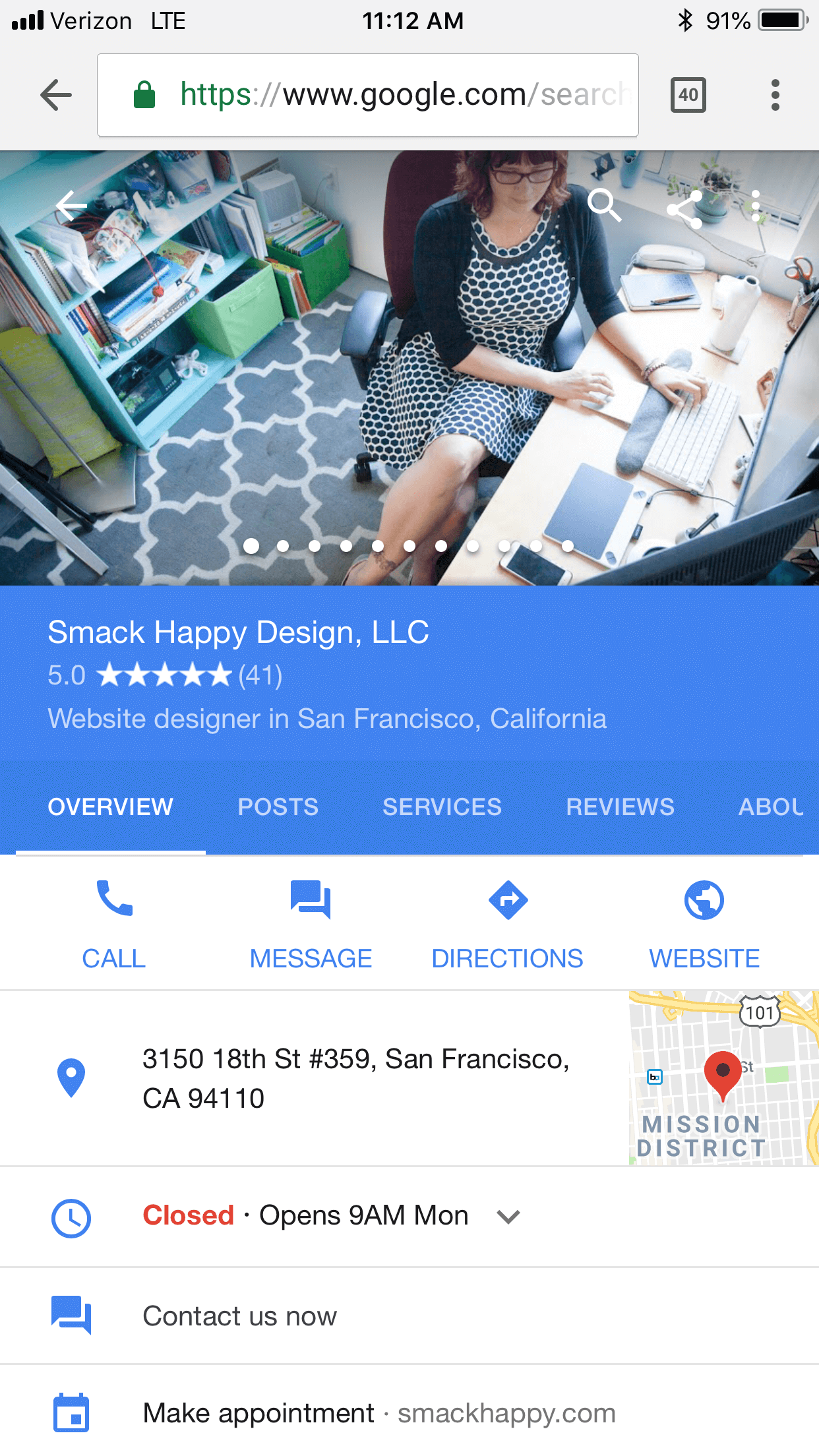How to Get More Results from Your Google My Business Listing
Think of it as a free advertising gift from Google. An optimized Google My Business listing gives you a major boost in local search results, gets your business on Google Maps and other Google services. Even better, optimizing your listing is easy and free.

May 28 2018 ● 14 min read

Everybody wants more customers. Local businesses, online businesses, home-based businesses.
But getting those customers can be hard. Expensive. Time-consuming. Especially if you don’t have great marketing skills or the time to learn them.
Many local business owners find themselves in that fix. They’re smart, capable people, but marketing is not their first love. Their business and its core products and services are their first love – and a demanding responsibility.
Still, to keep their small business afloat, they know they need to be visible to people looking for what they sell or offer.
So they have to do some marketing. Even if it gets done at the kitchen table after 10 PM at night.
Google understands this. They know many local small business owners struggle with marketing their businesses. They know they don’t have a lot of time to do their marketing, and that often they don’t have advanced marketing skills or even the time and energy to learn them.
So they set up Google My Business Listings.
These are free, easy-to-manage listings that get your business in front of thousands of customers – without spending a lot of time, or money, or having to go to school to figure out how to use them.
Google My Business listings also supply the data Google uses for many of its other products, like Google Maps, Google’s Local Pack, organic search and more.
Here’s an example of Google Local search results. The information shown here comes from these businesses Google My Business listings:
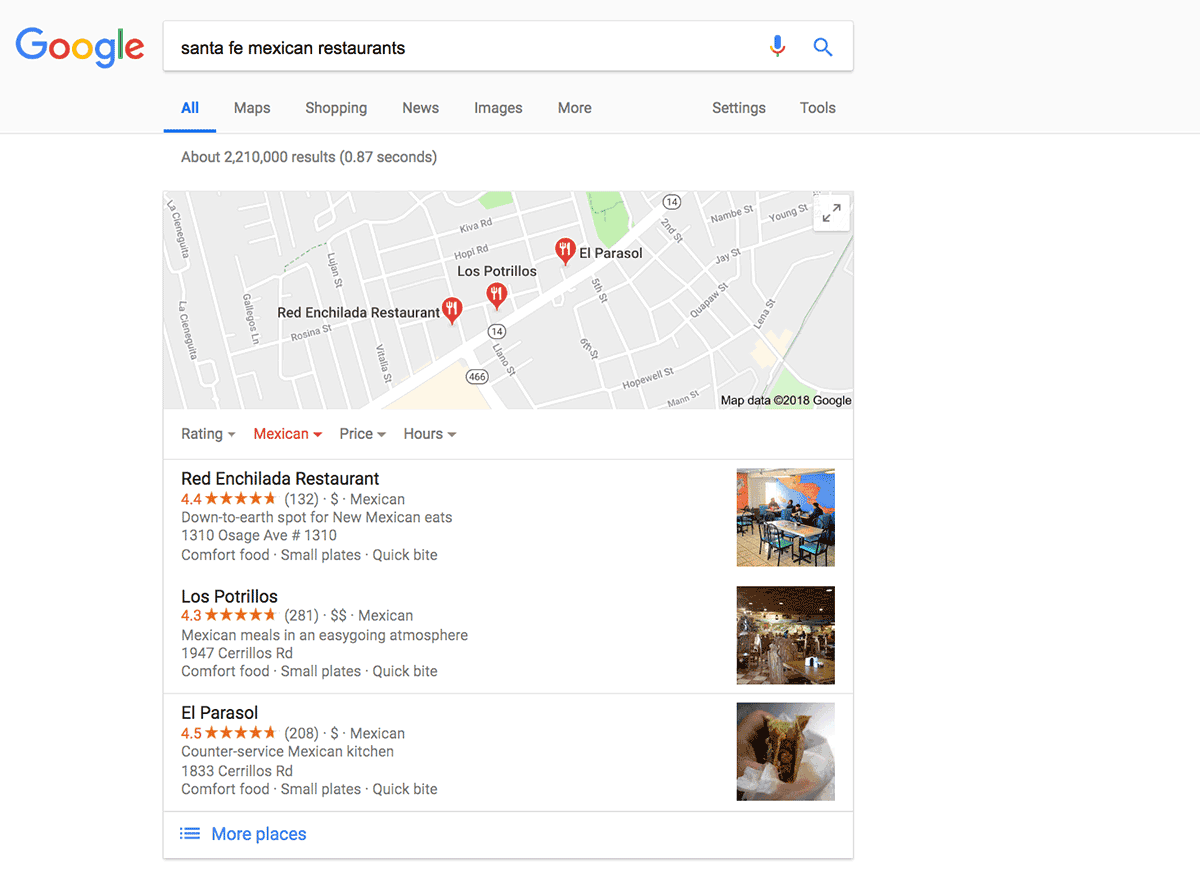 Google My Business listings are so easy to set up, so good for getting in front of people looking for your services, and increasingly so good at converting traffic into customers, that if you only did one piece of marketing for your business… optimizing your Google My Business listing would be a good choice.
Google My Business listings are so easy to set up, so good for getting in front of people looking for your services, and increasingly so good at converting traffic into customers, that if you only did one piece of marketing for your business… optimizing your Google My Business listing would be a good choice.
So if you’ve got a listing already, or you want to kick your existing listing up a notch, keep reading. We’ve got eight to-do items for those of you who are just getting started with Google My Business, and eight to-do items for those of you who already have a nice listing and want to make it even better.
How to optimize your Google My Business Listing: The simple stuff
1. Claim and verify your listing.
Okay – pretty obvious here. But just in case you haven’t done it, know that this can be done in literally ten minutes or less. (Seriously; I timed it.)
To sign up, go to Google my business. You’ll be asked some basic information about your business, like:
- Whether you do indeed deliver goods and services to customers from this location
- Your address and phone number
- Your business category
After that, you’ll be asked to verify your business. This is super easy: Give them your business phone number and they’ll send you a text with a six-digit code. Enter that code and your account is verified.
You’ll see a page like this where you can start setting up your account:
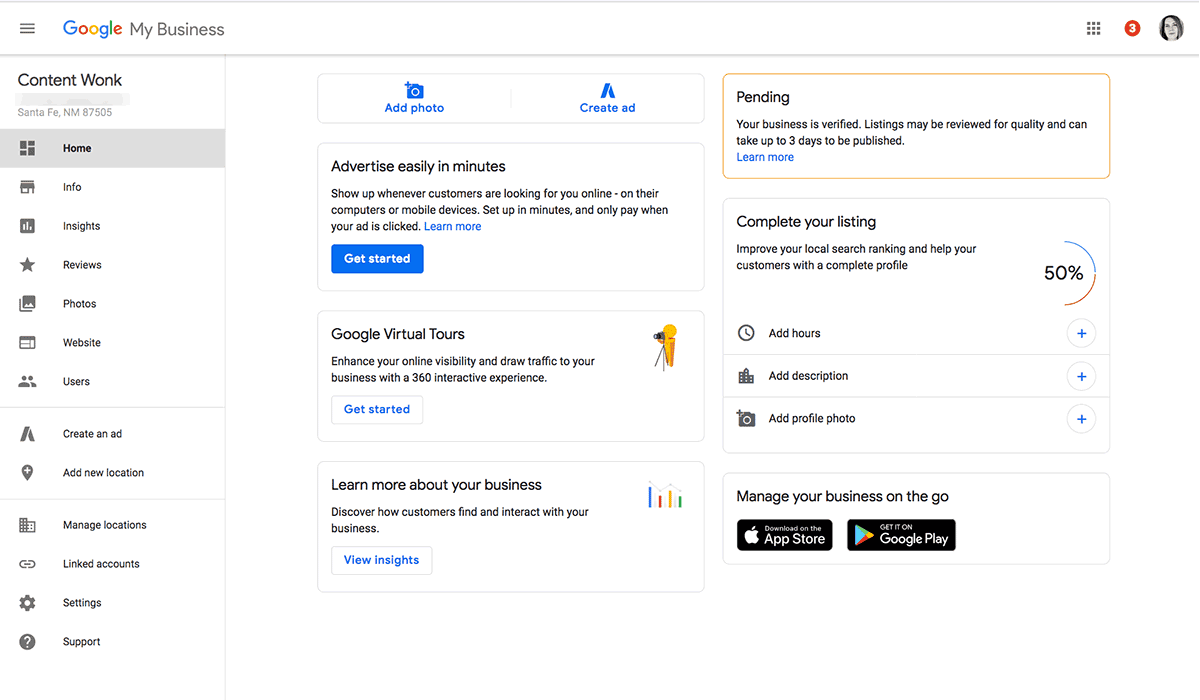
Editor’s Note: Google’s small business services change a lot. What’s available in Google My Business dashboard may change. So if you find your account to be a little different than what we’ve outlined here, that’s kind of the nature of Google My Business listings.
2. Add your business name.
Your official, legal business name. Don’t add special characters, or try to squeeze in any keywords. Google frowns on keyword stuffing in any part of a Google My Business listing. Trying to circumvent their rule about this may get your account suspended.
3. Add your business category.
Get as detailed as you can. Google is pretty good about this, actually. If you’ve got any kind of recognizable local business, they’ve probably got a category for it.
4. Add photos.
Of course, it would be great if you could hire a professional photographer to take photos of:
- You (the owner/founder)
- Your managers and customer service staff
- The view of your business from the street
- 2-3 views of parts of your store
- A view of the cash register
But if you don’t have the budget for a photographer, no worries. An iPhone or Android will do.
Here’s some advice for your amateur photoshoot: Try to get the best possible light. Consider taking photos of your store during the morning or late afternoon if the light and your photos happen to look better then.
Take a bunch of different photos and then pick at least three to add to your listing. Or use the photo categories Google offers:
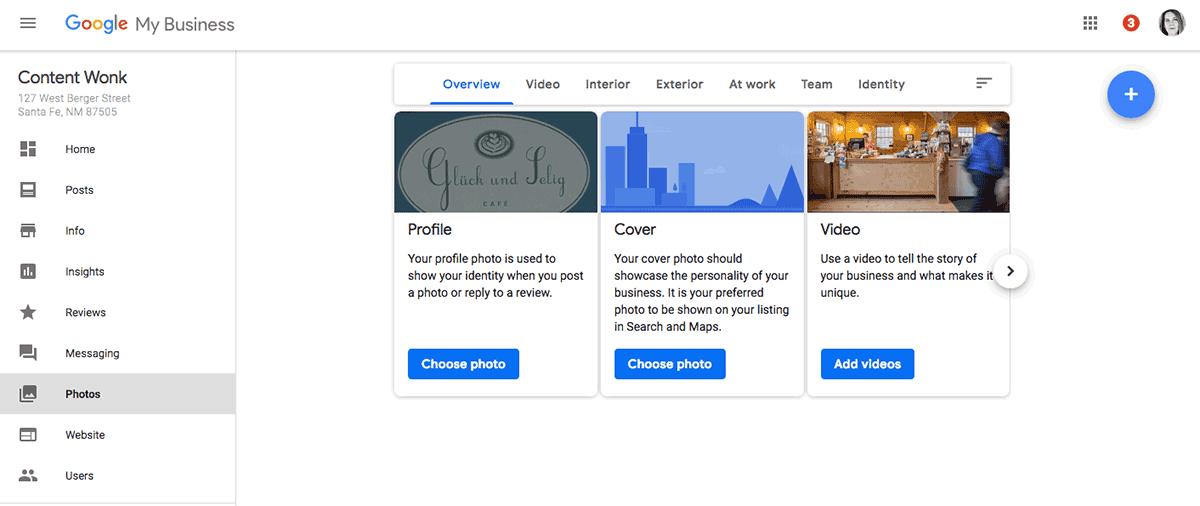
Google's photo requirements are pretty straightforward.
- No drawings or “non-photos” of your business.
- No images with more than 10% overlaid text.
- No funky Instagram-style filters.
- No really dark or low-quality* images allowed.
- Use .jpg or .png files.
- Size should be between 10KB and 5MB.
- Minimum resolution is 720px tall and 720px wide.
What does “low-quality” mean? Well, get good enough light so everything in the photo is easily recognizable, and make sure the resolution of your images is 144 dpi, not 72 dpi. Save your photos as at medium-quality jpegs if you can.
As the hokey saying goes, a picture is worth a thousand words. But more importantly, pictures build trust and familiarity. The quality of your photos will affect how much business you get from your listing.
5. Add your business hours.
Please. Because not having business hours listed is really frustrating for people. Besides, this will literally take you two minutes to do.
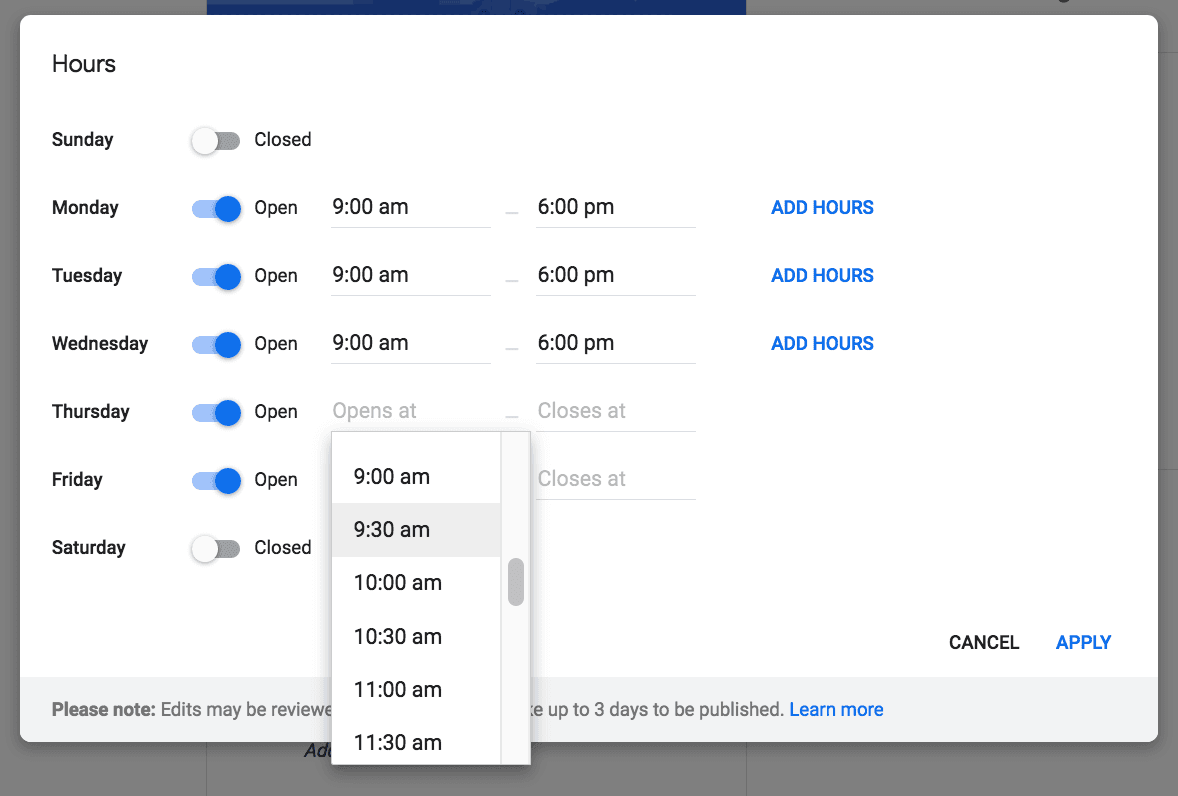
6. Respond to every review you’ve gotten.
Answer every review that’s been left for your business. A simple cheery, “Thanks for the kind words, [Reviewer’s First Name]!” is a good start, but put some effort into being authentic. Imagine the person who left the review is standing in front of you… what would you say?
Here’s how a UK SEO firm responds to their reviews:
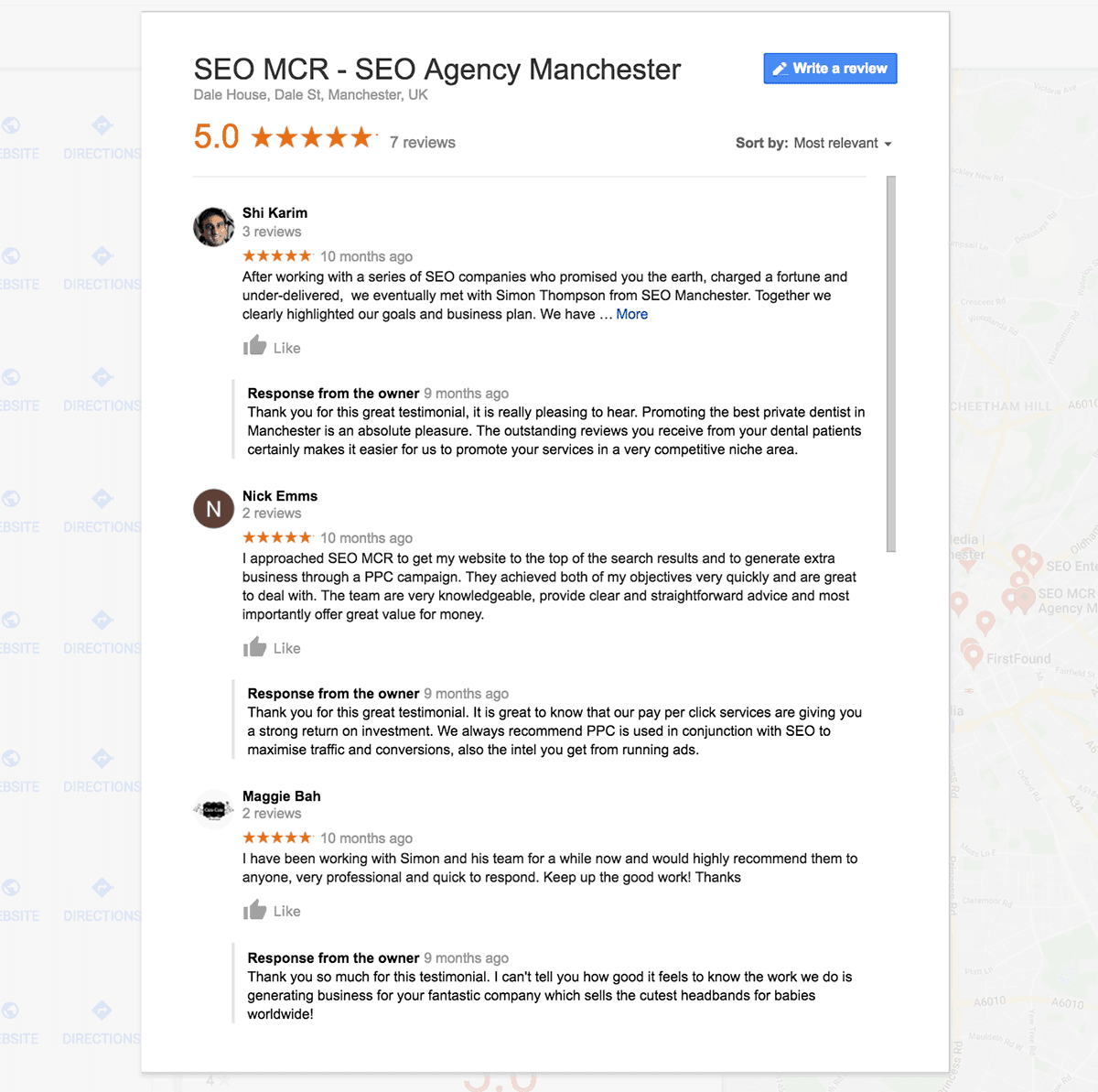
If the review is not so nice, it’s even more important you reply. Start by saying you’re sorry the customer had a bad experience. Then mention what you have done or can do so it doesn’t happen again. Then invite them back to your business, maybe for a small free token of goodwill.
That’s just the first thing you need to do for your reviews. The next job is to get more reviews for your business.
Fortunately, Google does let you ask for reviews. This is different from GMB’s main competitor, Yelp, where you are strictly forbidden to ask for reviews. In fact, Google is so supportive of you asking for reviews that they’ve created instructions for how to create a link on your site so people can go directly to the page where they can submit a review for you. You can insert the link to your website or HTML email signature inviting people to leave a review with every business email you send. Now you can also create your own Google Review QR code or make one using any of these best QR code generators make it easier for people to leave you testimonials.
Key takeaway here: Reviews are super-important to local businesses now. Customers read them very closely and decide which business to go to based on them. So pay attention to your reviews, and respond to each one. Customers know a business that responds to their reviews is a business that actually cares – not just says they care.
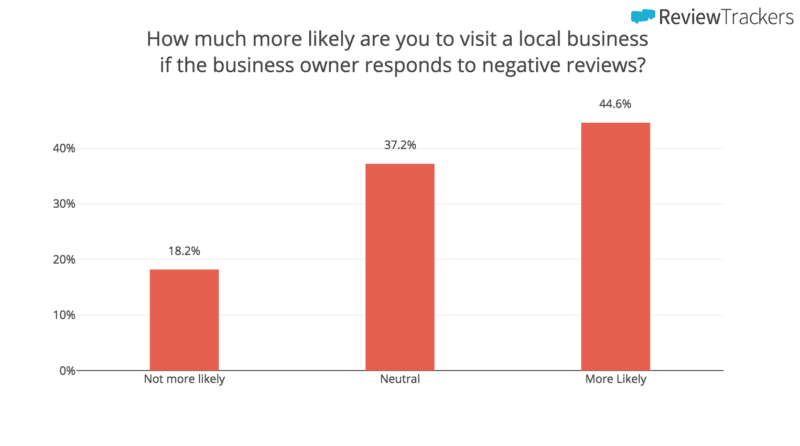
7. Write a great description.
Google had removed business descriptions up until just a few months ago, but happily, we’ve got them back.
And while we know you’re busy, please don’t just dash this off and move on. Your business’s description is important enough that it’s worth thinking of writing it as its own task. Consider setting aside an hour or so to really make this good.
Here are some guidelines for making it really good:
- First, avoid the stuff that could get your listing suspended. So make sure there are no typos, and don’t use ALL CAPS or any funky special characters to try to stand out. No keyword stuffing either, please – it won’t help your rankings. Also, don’t mention special promotions in your business listing, even if it’s a promotion you’ve offered for years. Of course, there must be no swearing, hate, illegal activities or substances offered, and nothing sexually explicit. Finally, don’t include any links in your description. There’s space for them elsewhere.
- Embrace brevity. Google descriptions are only 750 characters. You’ll also need to write your description so the first 250 characters can stand on their own – it’s those first 250 characters that show up in many of the views of GMB information.
- Avoid superlatives like “We’re the best” unless you’re quoting a third party that said you were the best.
This is where you business description appears. Note that the description is truncated.
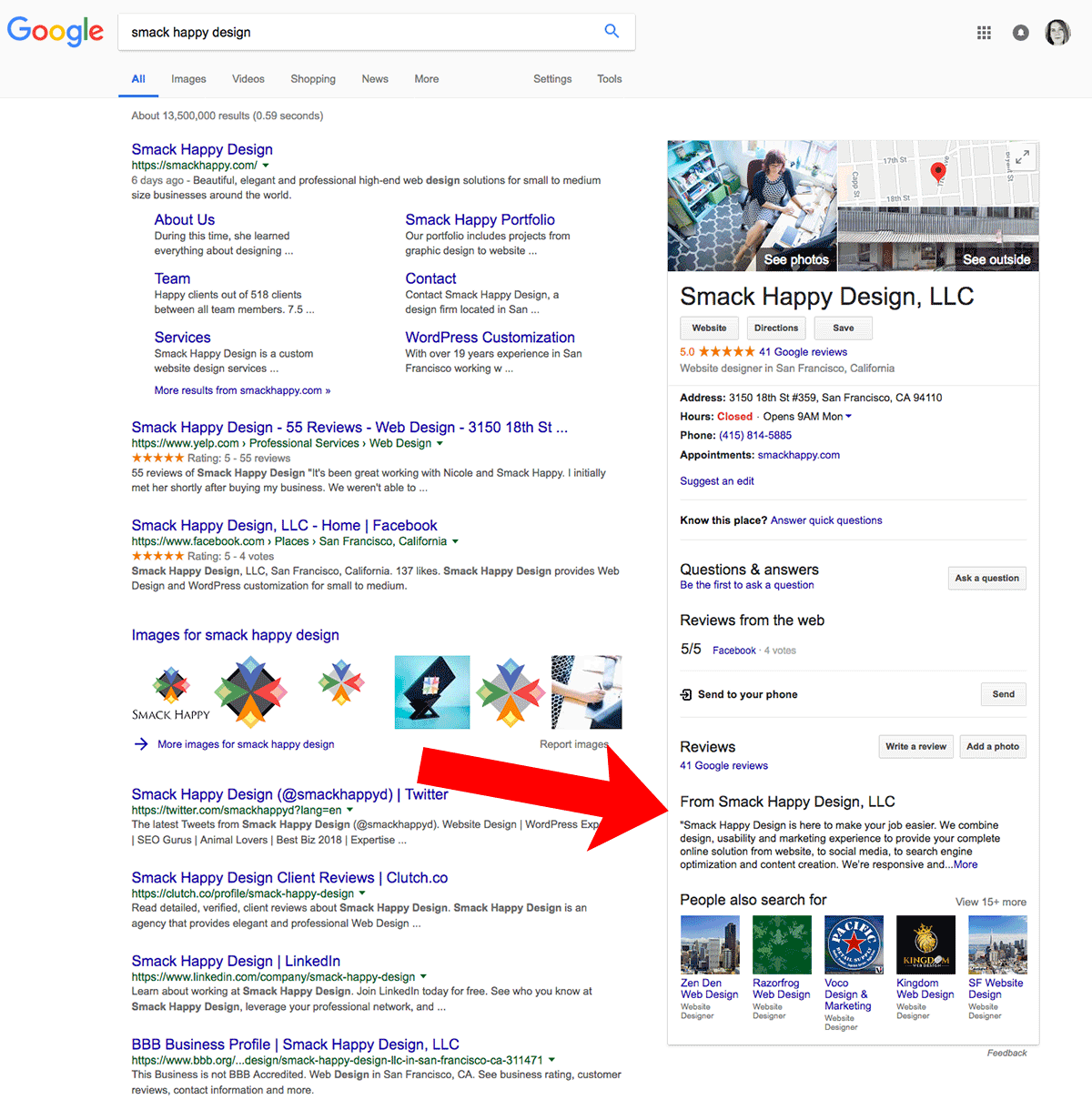
You have to click the “More” link to see the full description.
8. Choose a contact email you check daily.
As we’ve seen, there are a lot of reasons to pay attention to your Google My Business listing.
But there’s one very compelling reason we haven’t mentioned yet.
It’s not just your or your marketing staff that can edit your listing. Anyone can.
An angry customer. A competitor. A disgruntled employee. A kid with too much time on their hands. Any of those people can make a change to your Google My Business listing at any time.
All they have to do is click “Suggest an edit” from your listing:
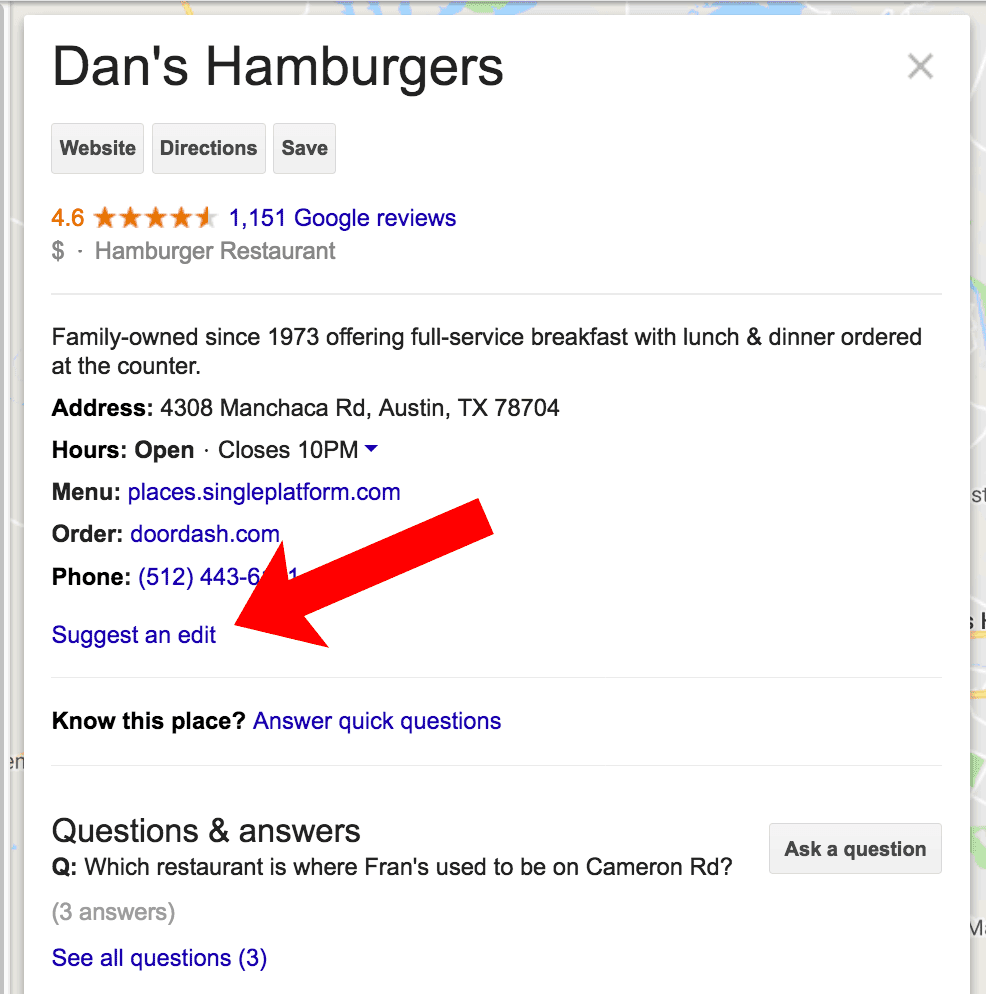
They can change almost anything, from something modest like changing your hours of business to something more damaging like changing your business category, or by even removing your Google My Business listing.
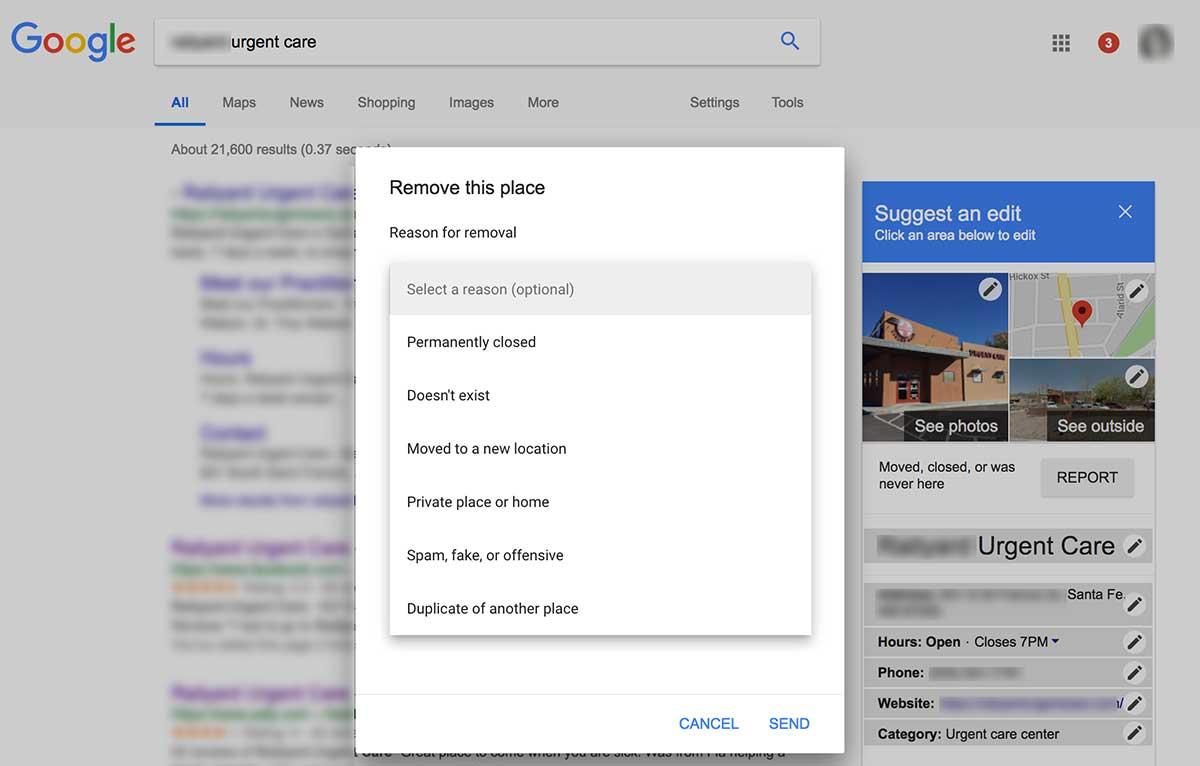
Anyone can make edits to your Google My Business listing. A doctor’s office could be re-categorized as a mortician.
What’s worse, you may not even get a notification. Google does send notifications to the one primary email listed on your account. But they don’t appear to send them to the emails defined as “Manager” or “Account Manager”, and reportedly even the primary account email doesn’t often get a notification if a change has been made.
Even in the Settings control panel of your GMB account, there is no explicit notification to alert you when someone makes a change to your listing.
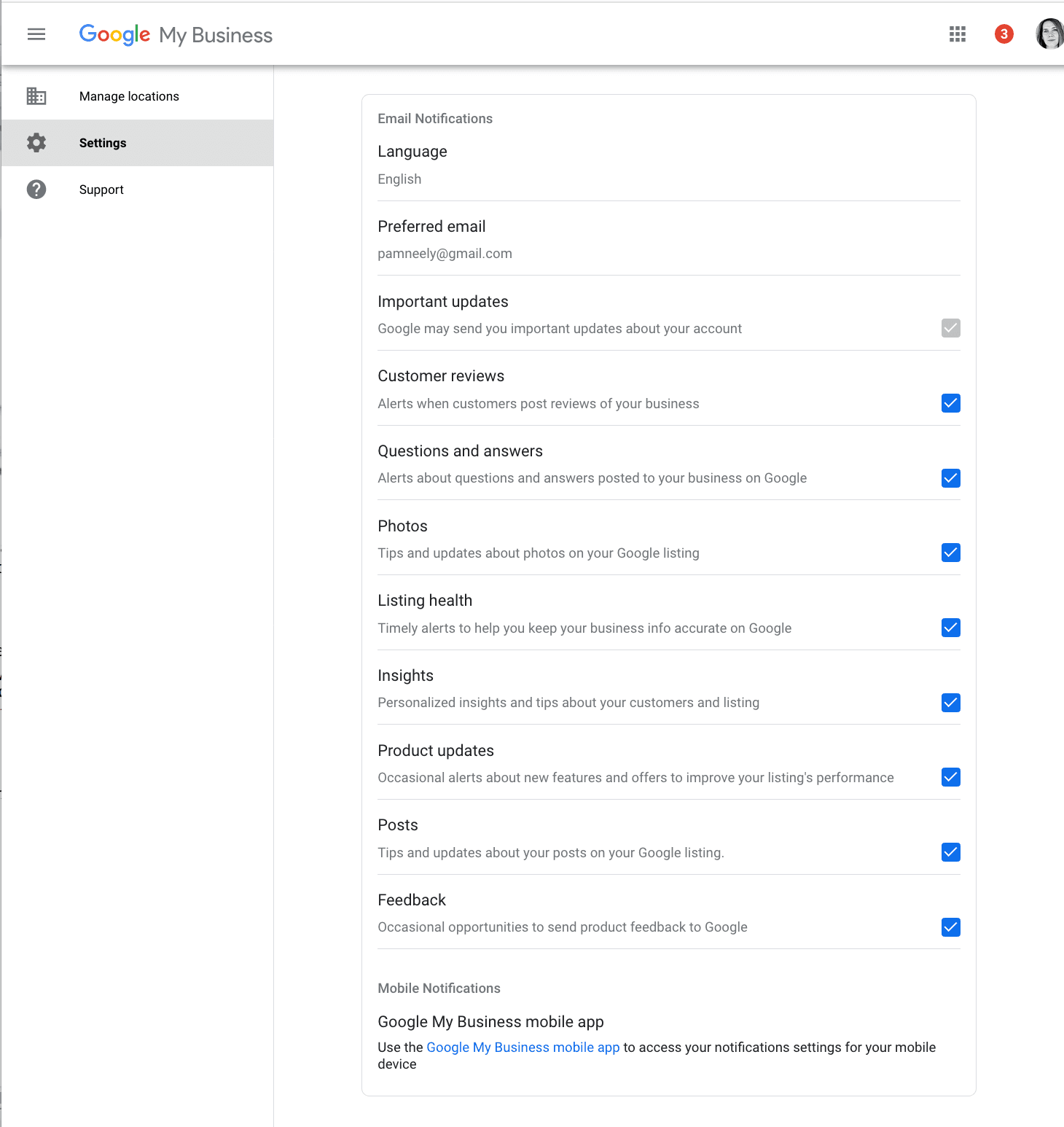
This may change, of course. Google is always improving their products. But for now, it’s something you need to be aware of. It’s also one of the best reasoning going to closely monitor activity in your GMB account, and to get frequent Google my business reports.
In the meantime, just make sure that you’ve got your account set to send the “Owner” every possible notification. You can control this in the “Users” section of your account, as shown below.
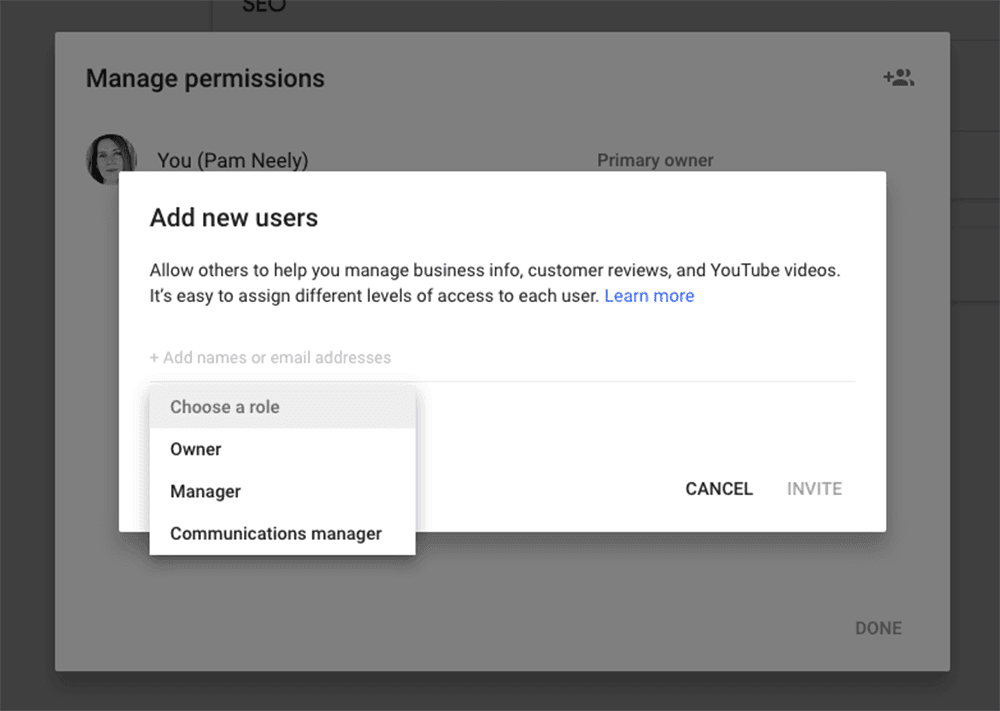
How to optimize your Google My Business listing – the more advanced stuff
1. Add a “menu” or “services” listing if it’s appropriate.
This is a rarely-used feature for businesses that don’t serve food, but it is an opportunity for any business that has a list of standard services with specific costs – like the services offered at a spa, at a dry cleaners, or even a local lawn care company.
Here’s exactly how Google describes this feature:
“There are two kinds of menus:
- A menu for an eating and drinking establishment (like restaurants or cocktail bars) that lists the complete set of food and drink items that are available at the business.
- A menu for a service business like a barber, spa, or car repair shop that lists the complete set of services that are available at the business.”
They describe which businesses are eligible to include these “services” listings here, saying,
“This feature is currently only available for food and drink, health and beauty, and services businesses that don't already have a third-party-provided menu link.”
As the Google guidelines for menus also state, “Sample menus that only list “popular items” (or similar excerpts) should not be submitted.” So make your services listing complete.
It’s not hard to do. Here’s an example of a very simple services listing I created in less than five minutes.
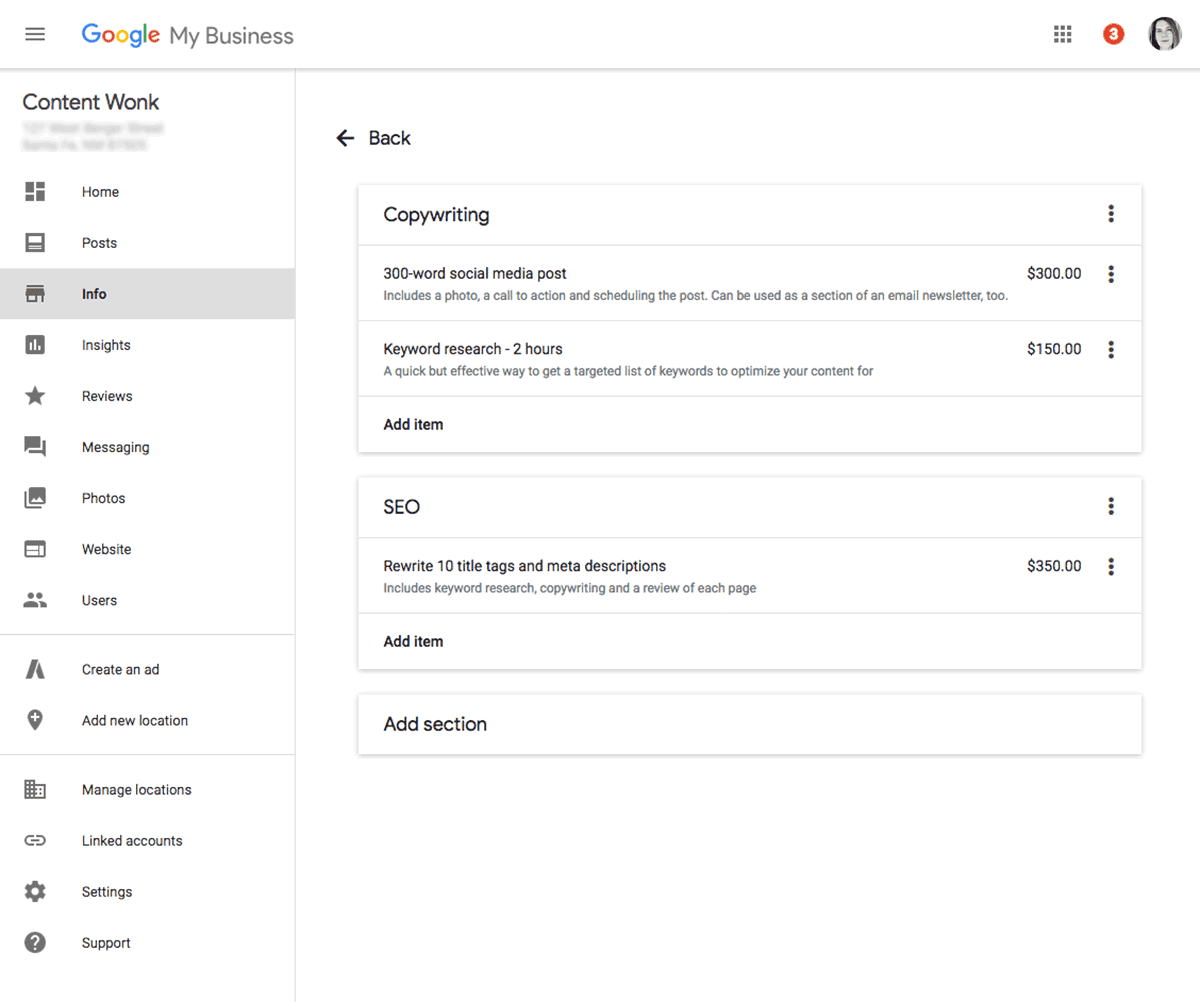
2. Get a virtual tour done.
Pictures are great, but if you and your competition have already covered the basic photos, it might be smart to hire one of Google’s virtual tour photographers so you can add this to your listing.
Retail shops might especially benefit from this, but even a hardware store could get a few more customers by letting people get a peek at their store aisles.
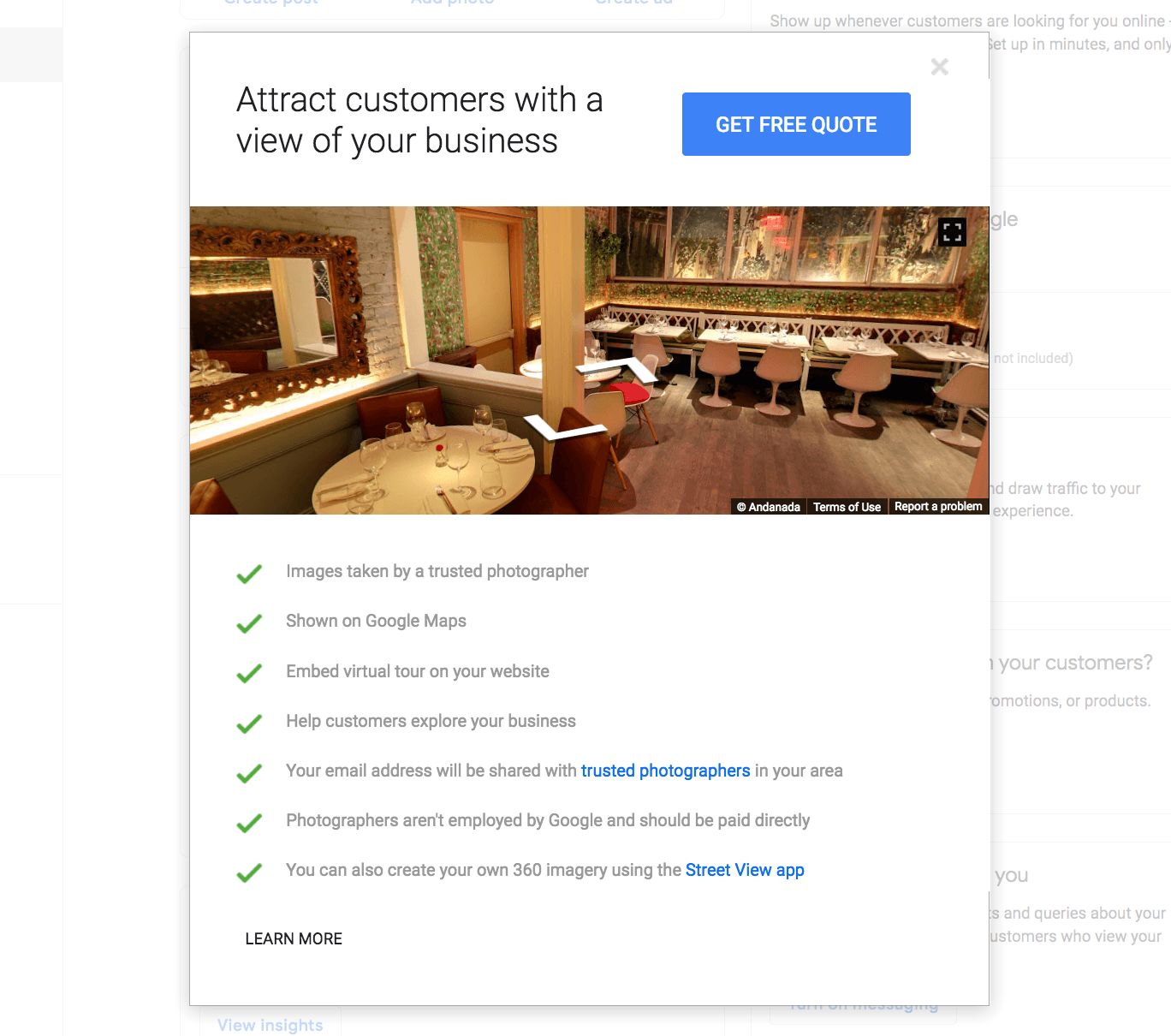
3. Write a few posts.
This is a new feature that seems to be a blend of Google+ posts, but also seems eerily familiar to Facebook posts. The good thing is the interface is familiar, and these posts are a great way to send messages and interesting updates to the people looking at your listing.
You can create three different post types, and add calls to action.
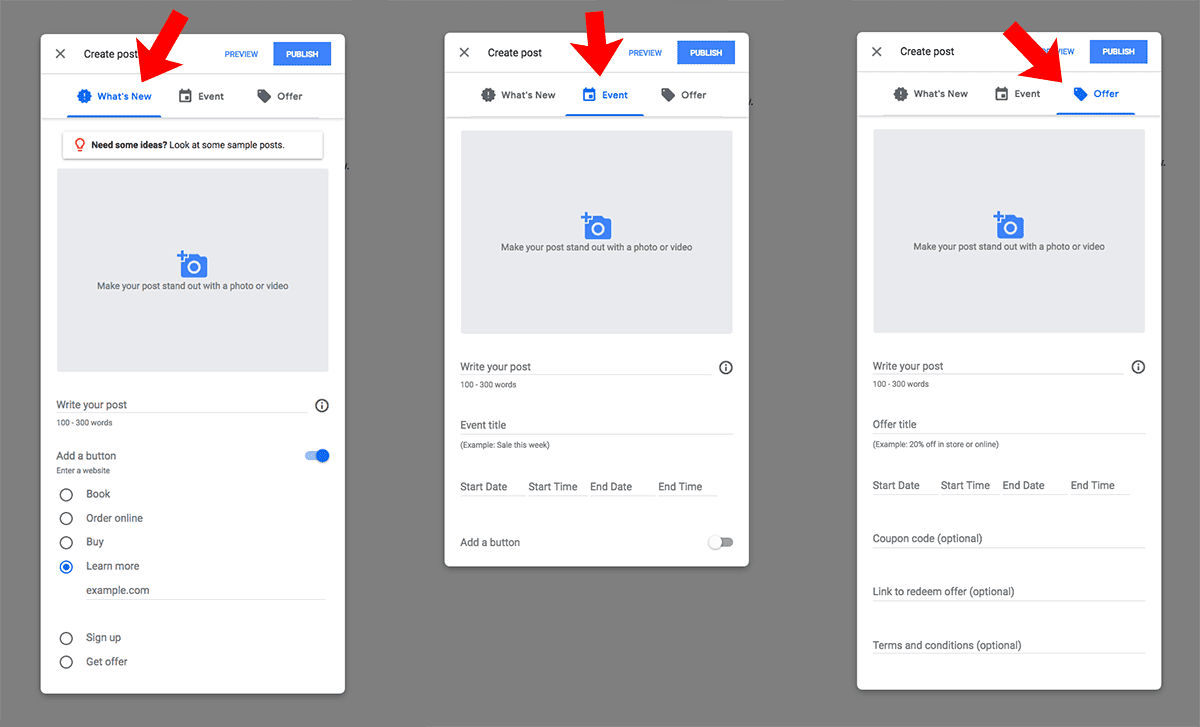
I especially like the “Sign up” button they offer for email newsletters. It’s an excellent way to build your email list.
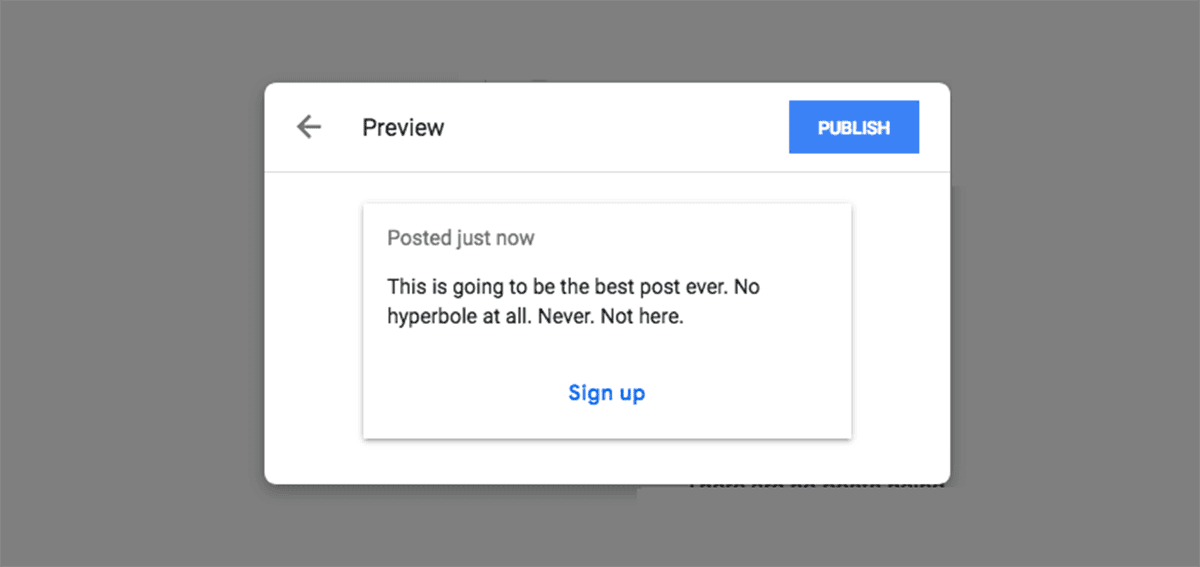
As mentioned before, don’t bother trying to “keyword stuff” your posts. It won’t help your site or your listing in the rankings. Don’t use hashtags, either. And keep it brief – you’ve only got about 300 words for each post.
But do try these. They show up very prominently in “the Knowledge Panel”, Google’s name for that box of information they show about your site.
Like this:
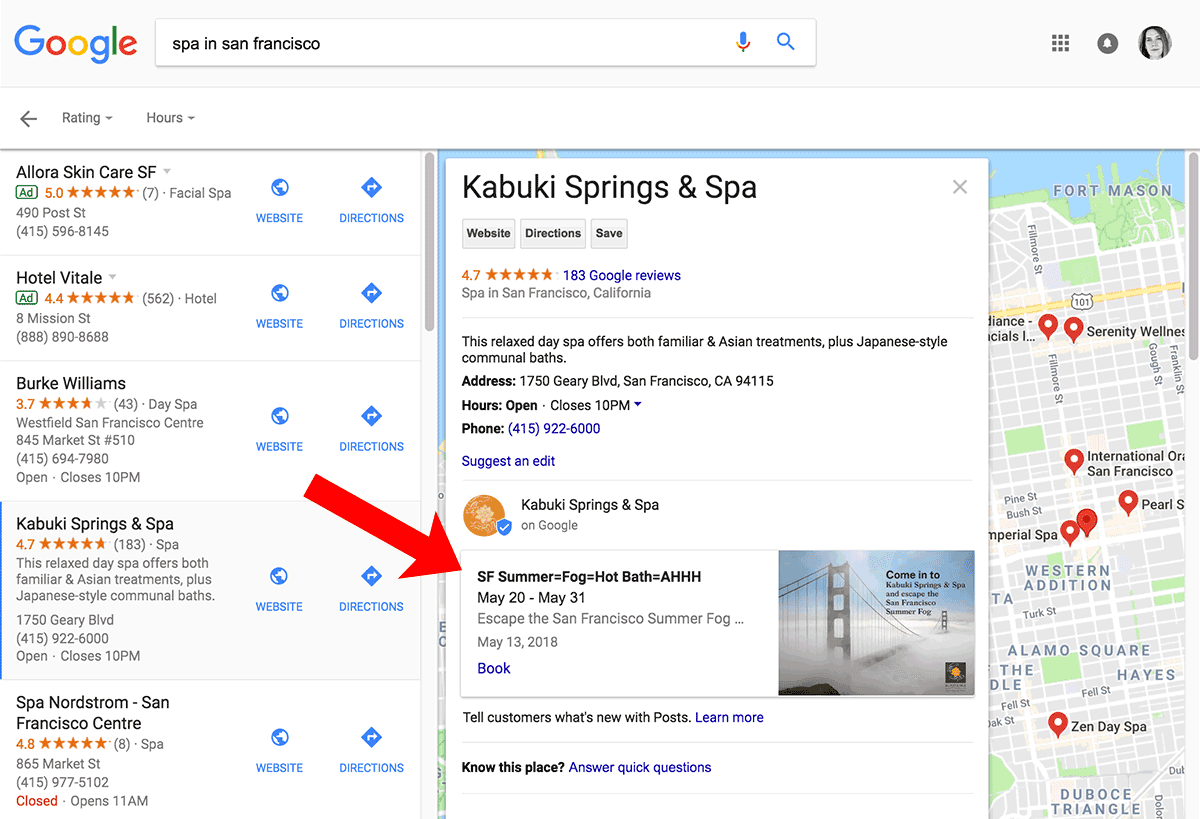
4. Set up your free website, if you don’t have one of your own.
Yes – Google My Business lets you assemble your information into a website-like page that they’ll host for you. For free. And the setup is very easy.
Here’s what you’ll see on the first page of the setup.
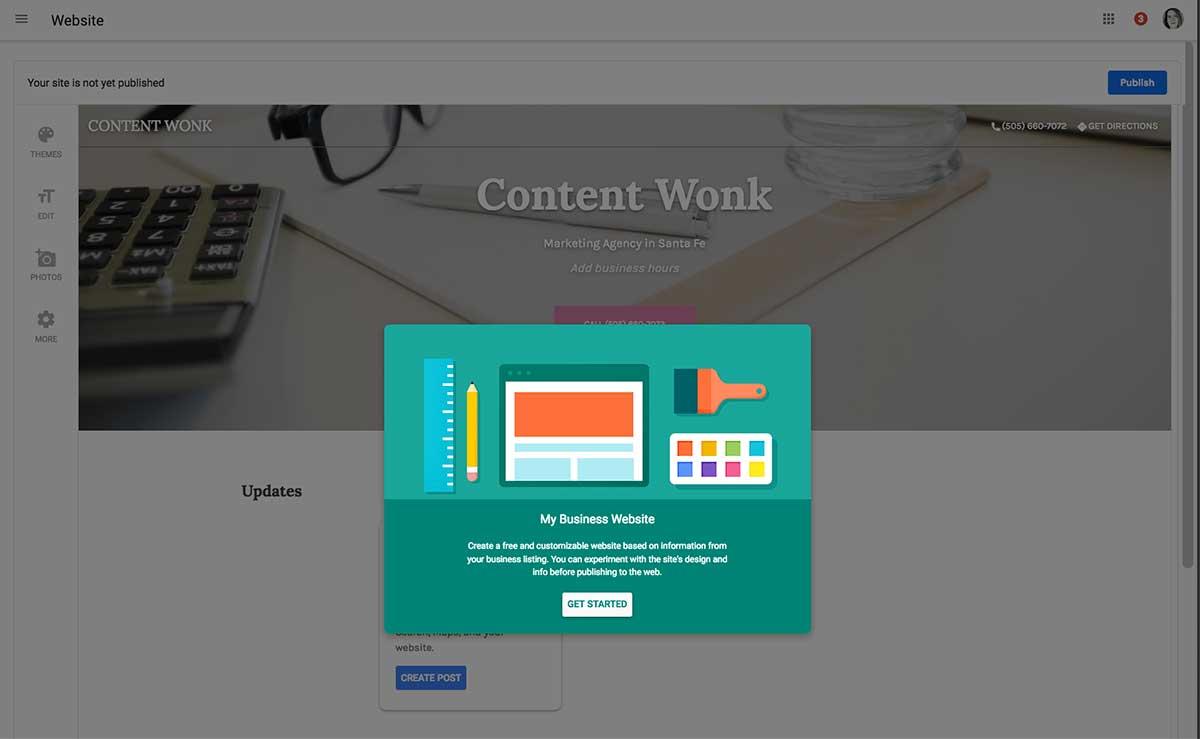
Next you’ll be asked to pick a theme (very similar to a WordPress theme).
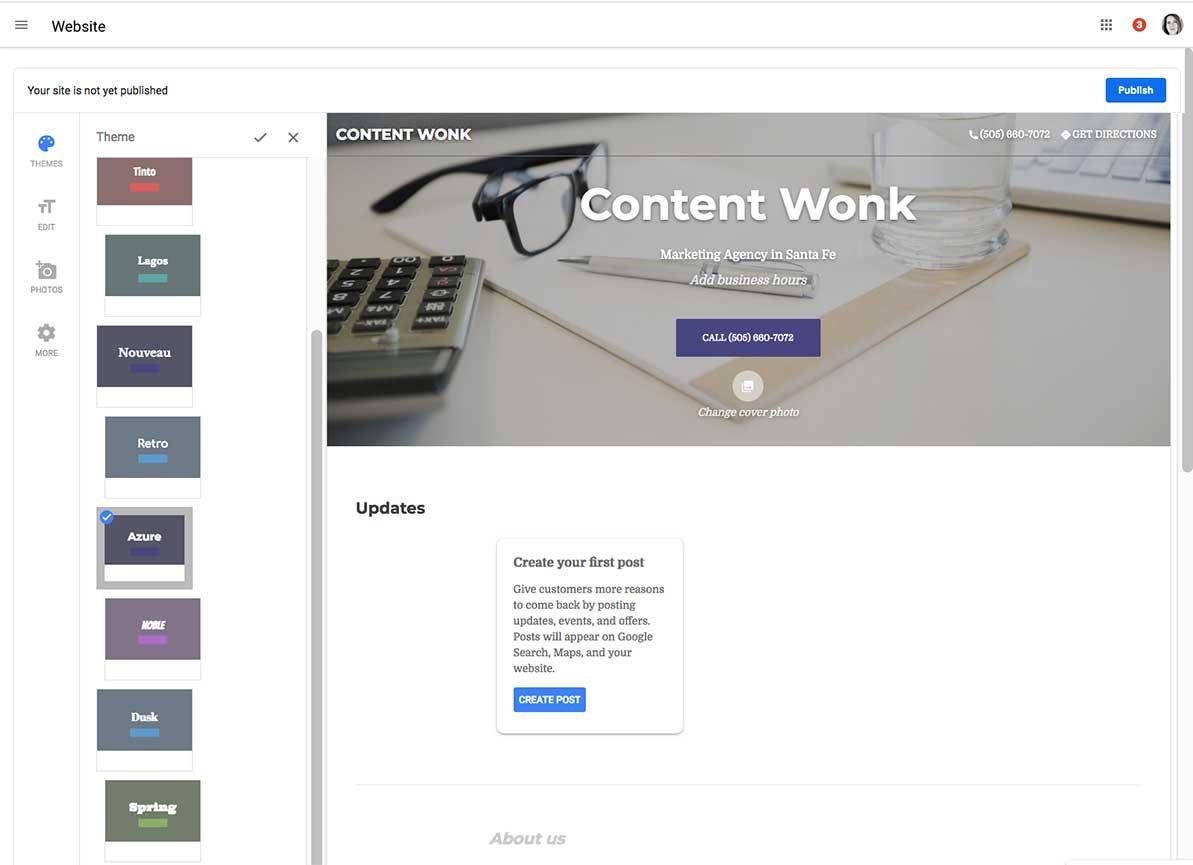
Then you’ll add your other business information (if you haven’t already done so elsewhere in your account).
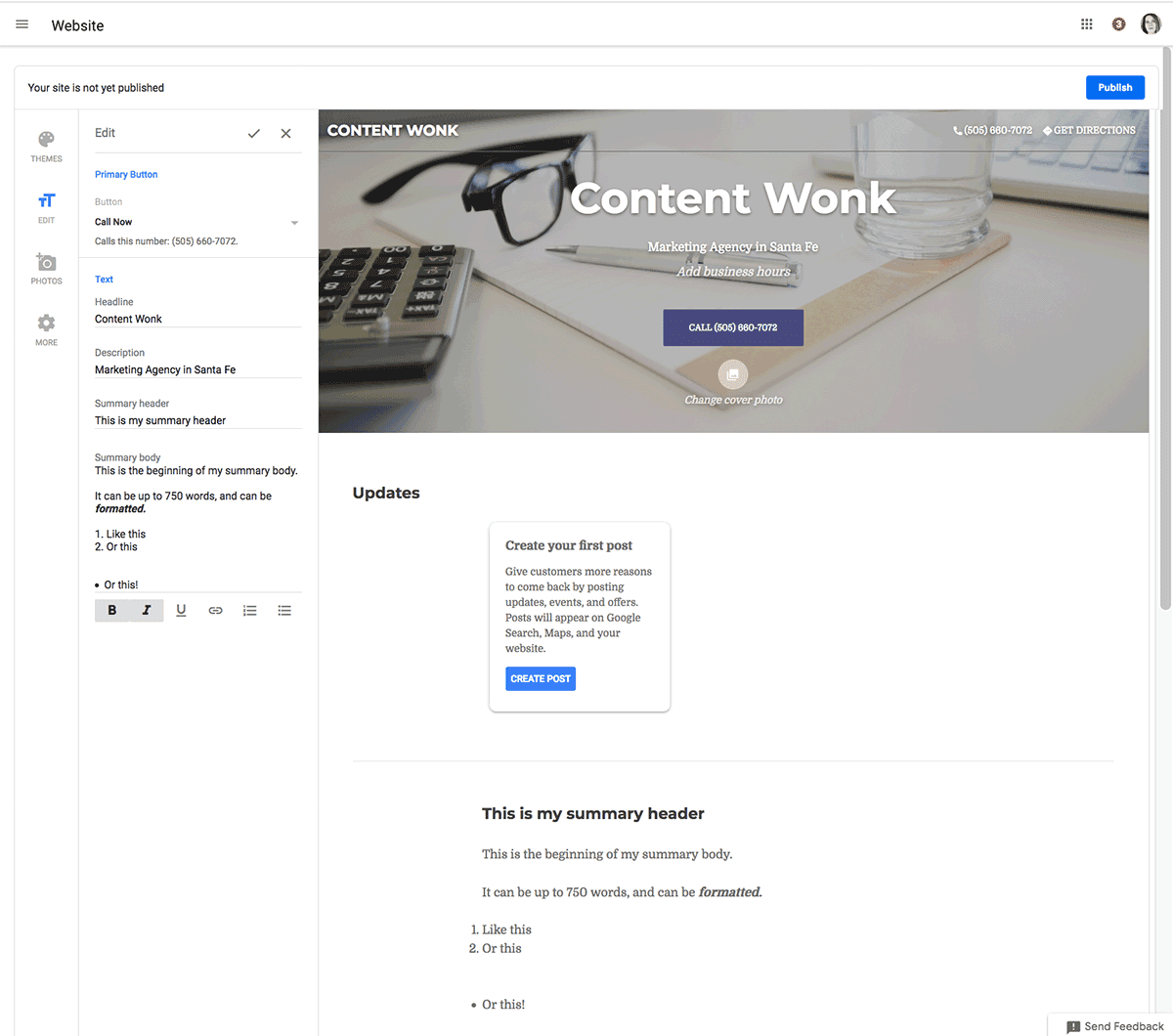
When you’re done, click publish. GMB will show you the URL (web address) of your new business site. They’ll ever guide you through the process of buying a domain name if you need it.
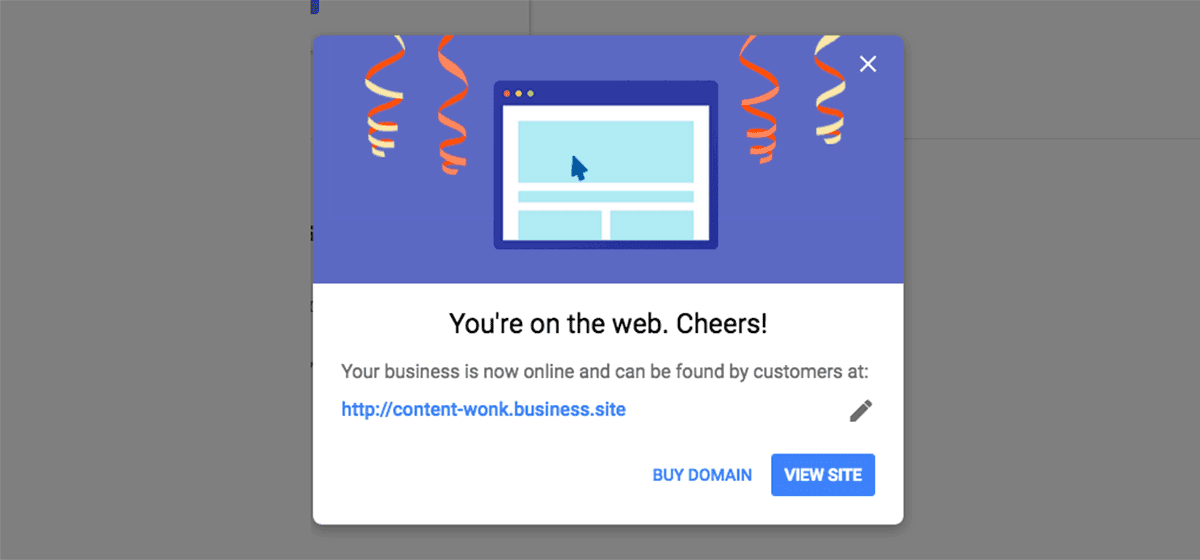
Your new, free, one-page website will look like this:

It’s certainly not fancy, but it has the basic information. Any time you change information in your GMB account, it will be updated on this site.
5. Set up messaging.
We’ve all been hearing a lot about Facebook Messenger, but did you know Google is offering something similar for small businesses, too?
It’s in your GMB listing. To set it up, just add a business number that you want to get and send messages from.
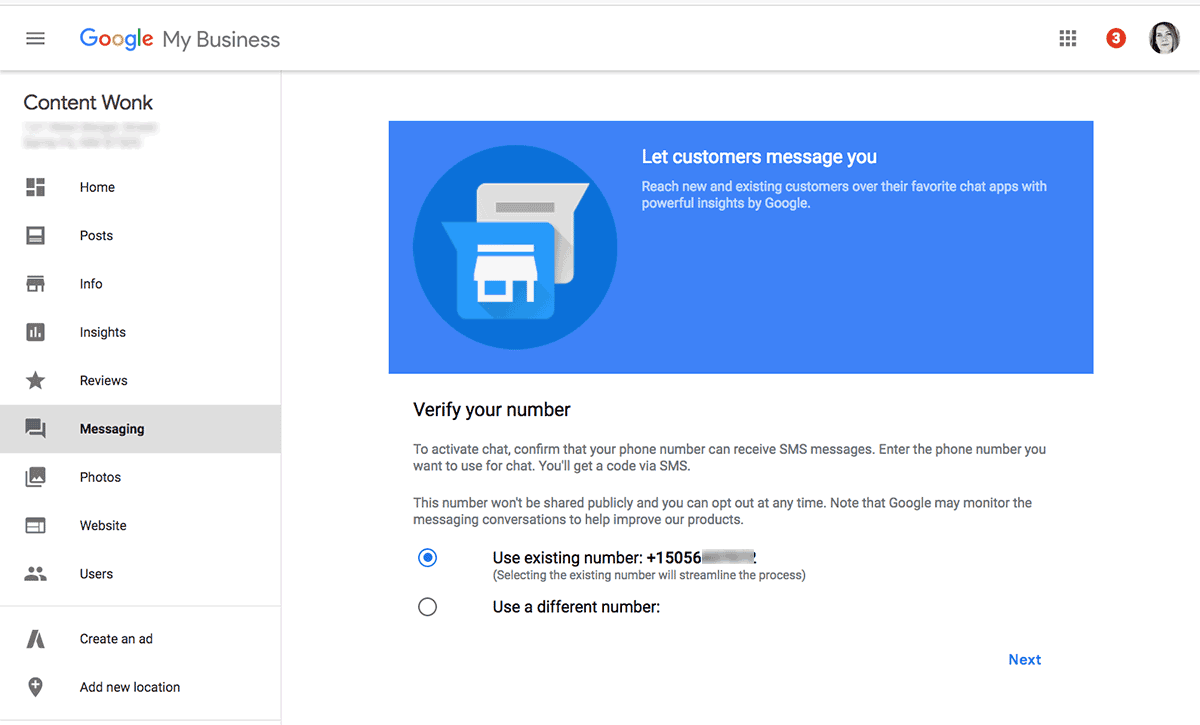
Then add your welcome message. Voilà – it’s good to go.
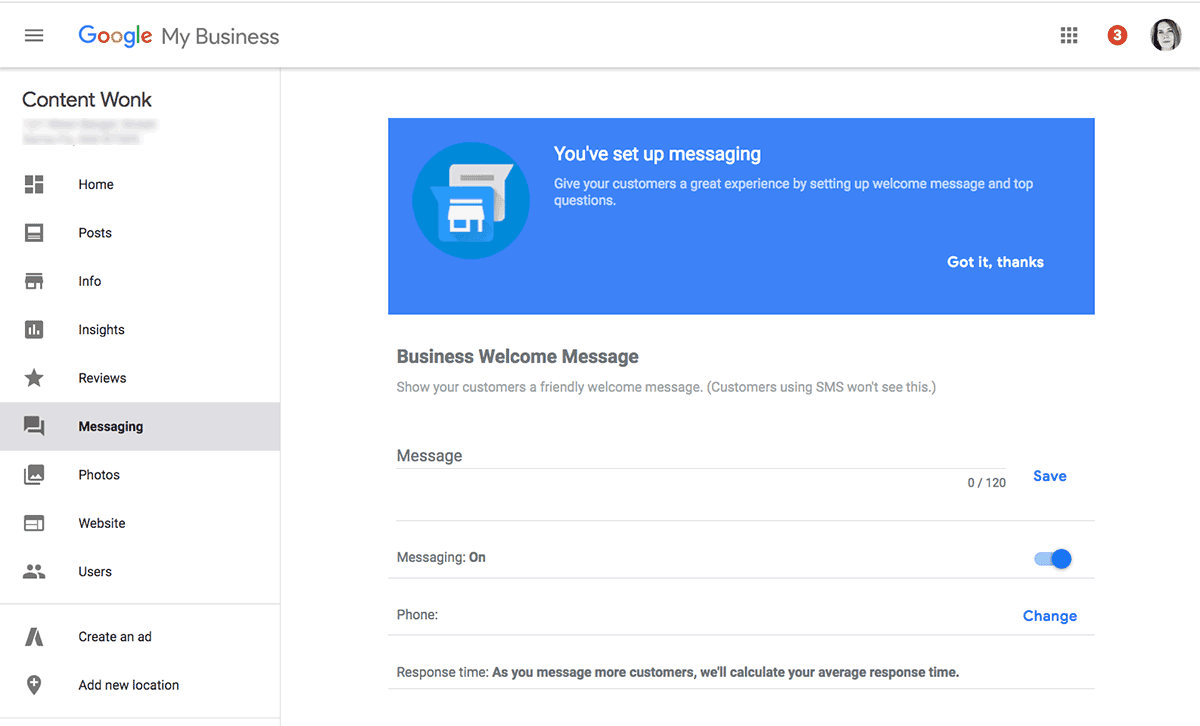
Once your messaging is set up, people will be able to message your company directly from your GMB mobile listing.
6. Manage additional locations.
Hopefully, your business has done so well that you’ve opened up a second location. Or maybe a third or fourth location.
They can all be managed from your GBM listing. You can even sort them into groups.
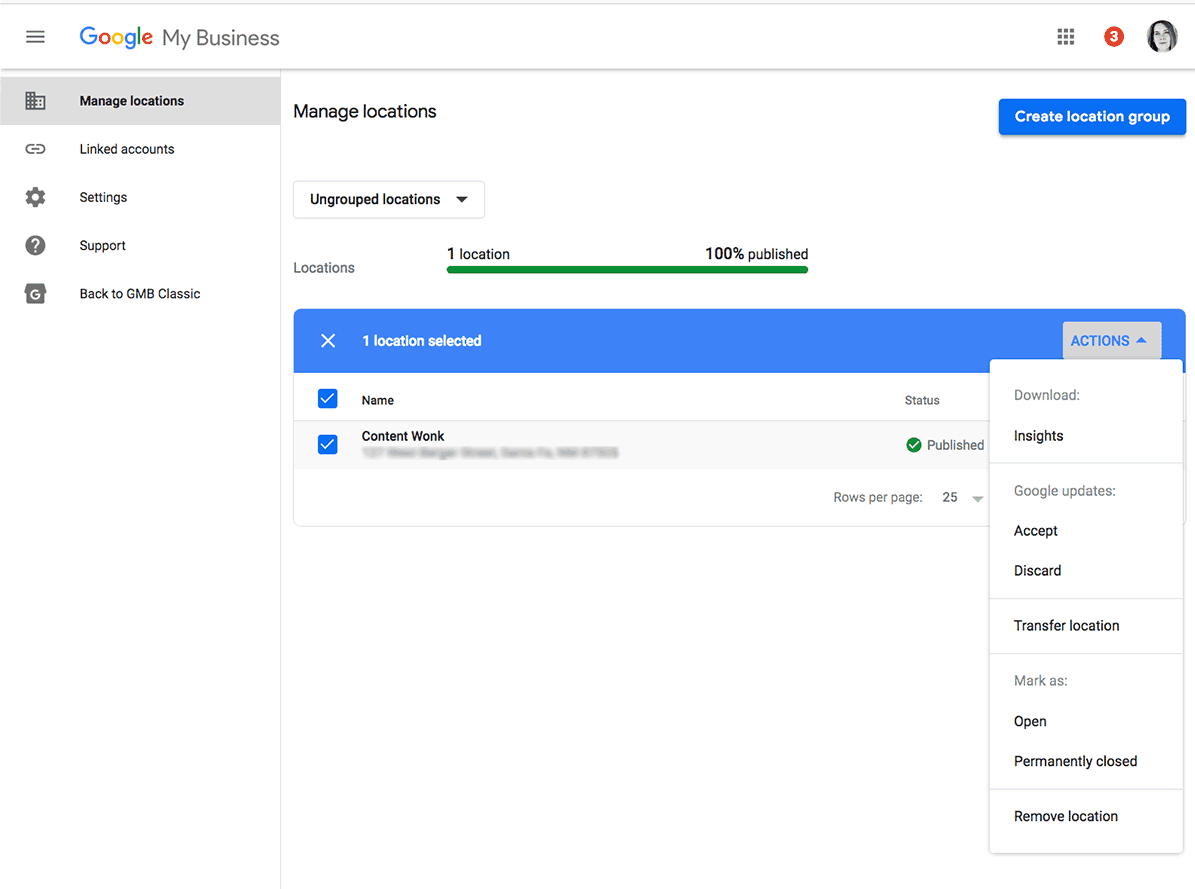
7. Check your reporting.
Okay, so this is one of the GMB features we love most. Go figure – we’re data wonks.
But there’s excellent information here. You can add data to your Whatagraph report via Google My Business API Integration. So, if you don’t have time to log in and check this information, no worries. Just set up your Google My Business report using Whatagraph's report template and we'll send you an automated email including all the important metrics to monitor in your local marketing report.
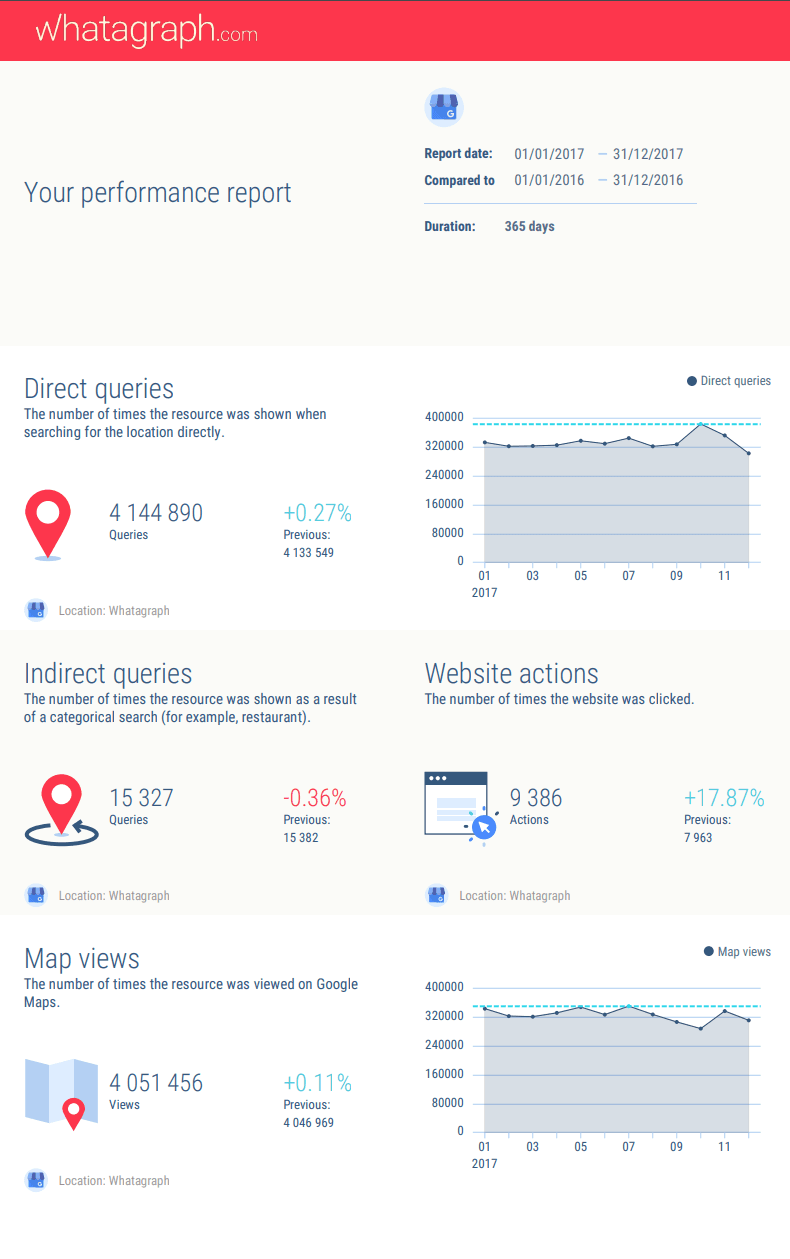
But if you still want to manually log in, that’s okay too. Here’s where to find the reports in you GMB account, and roughly what they’ll look like:

8. Add a video.
There’s been a lot written about the value of videos for small businesses. To give you the thumbnail version, know that videos don’t have to be long. In fact, Google won’t let you upload a video more than 30-seconds long. It also has to be 100MB or less, and 720p or higher.
Again, the lighting for your videos matters, but the audio may matter even more. Consider buying a simple lavaliere microphone that clips to your shirt. It’ll sync easily with your phone and help the quality of the audio in your videos a lot.
Here are three basic videos every business should have:
- A quick intro / explainer video of the owner, manager or founder. This should be short – perhaps 30 seconds, and definitely not more than 90 seconds. It’s basically an extended “elevator speech” style explanation of what your business offers.
- An on-camera customer testimonial video or two would go a long way to building trust.
- A short, fun video about something that makes you special. Even something really simple, like a short video about your company dog, and how he greets every customer who comes in.
Conclusion
If you’re a local business, optimizing your Google My Business listing is a no-brainer. It’s easy to do, effective, and free.
And while there is a darker reason to check your account regularly (so you don’t miss a malicious or incorrect change to your account), fortunately, it’s easy to stay on top of what’s happening. That’s true whether you log into GMB manually or have your account’s analytics sent via a customized emailed report.
Published on May 28 2018

WRITTEN BY
Pam NeelyPam is an award-winning freelance content writer with expertise in SaaS, MarTech, and small business marketing companies. A business book ghostwriter in her free time, Pam always writes from a B2B owner perspective.
